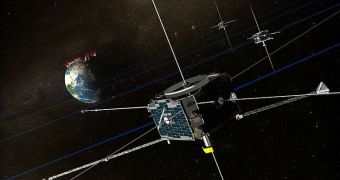NASA announced recently that it has reassigned two of its five THEMIS satellites in Earth's orbit to a new mission, called ARTEMIS. The main goal of the new research initiative is to determin how solar wind electrifies, alters and erodes the lunar surface.
When completed, the Time History of Events and Macroscale Interactions during Substorms (THEMIS) constellation featured five satellites that observed our planet.
Two of those spacecrafts have now been reassigned to the Acceleration, Reconnection, Turbulence and Electrodynamics of Moon's Interaction with the Sun (ARTEMIS) research initiative.
The proposal came earlier this year, and the two satellites, now working in tandem, began carrying out observations of the Moon earlier this week.
The information that ARTEMIS will obtain could be of tremendous importance for future human explorers making their way to the Moon. Additionally, scientists could also get more insight into how other worlds react to solar radiation.
“Using two re-purposed satellites for the ARTEMIS mission highlights NASA's efficient use of the nation's space assets,” explains NASA official Dick Fisher.
He is the director of the American space agency's Heliophysics Division, which is based at the NASA Headquarters Science Mission Directorate, in Washington DC.
“ARTEMIS will provide a unique two-point view of the Moon's under-explored space environment. These two spacecraft are headed for an incredible new adventure,” says expert Vassilis Angelopoulos.
He is the principal investigator of the THEMIS mission, and holds an appointment at the University of California in Los Angeles (UCLA).
The main targets for ARTEMIS are solar winds, streams of charged particles that are emitted by the upper atmosphere of the Sun. The satellites will study turbulences that appear in these streams.
The ARTEMIS spacecrafts left their original positions, and are now located on the L1 and L2 Lagrangian points, respectively. One of the points is located on the far side of the Moon, and the other on the satellite's Earth-facing side.
It took more than a year, and nearly all remaining fuel aboard the satellites to get them to these positions. “ARTEMIS is going where no spacecraft have gone before,” explains Manfred Bester.
He is the mission's operations manager, and he is based at the University of California in Berkeley (UCB), from where ARTEMIS is operated.
“We are exploring the Earth-Moon Lagrange points for the first time,” he concludes.

 14 DAY TRIAL //
14 DAY TRIAL //